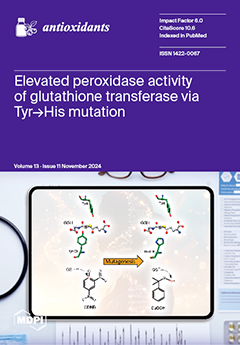Cystathionine γ-lyase (CSE) is the second enzyme in the trans-sulfuration pathway that converts cystathionine to cysteine. It is also one of three major enzymes responsible for the biosynthesis of hydrogen sulfide (H
2S). CSE is believed to be the major source of
[...] Read more.
Cystathionine γ-lyase (CSE) is the second enzyme in the trans-sulfuration pathway that converts cystathionine to cysteine. It is also one of three major enzymes responsible for the biosynthesis of hydrogen sulfide (H
2S). CSE is believed to be the major source of endogenous H
2S in the cardiovascular system, and the CSE/H
2S system plays a crucial role in a variety of physiological and pathological processes. However, the regulatory mechanism of the CSE/H
2S system is less well understood, especially at the post-translational level. Here, we demonstrated that the persulfidation of CSE inhibits its activity by ~2-fold in vitro. The loss of this post-translational modification in the presence of dithiothreitol (DTT) results in a reversal of basal activity. Cys137 was identified as the site for persulfidation by combining mass spectrometry, mutagenesis, activity analysis and streptavidin–biotin pull-down assays. To test the physiological relevance of the persulfidation regulation of CSE, human aortic vascular smooth muscle cells (HA-VSMCs) were incubated with vascular endothelial growth factor (VEGF), which is known to enhance endogenous H
2S levels. Under these conditions, consistent with the change tendency of the cellular H
2S level, the CSE persulfidation levels increased transiently and then gradually decreased to the basal level. Collectively, our study revealed a negative feedback regulation mechanism of the CSE/H
2S system via the persulfidation of CSE and demonstrated the potential for maintaining cellular H
2S homeostasis under oxidative stress conditions, particularly in tissues where CSE is a major source of H
2S.
Full article






